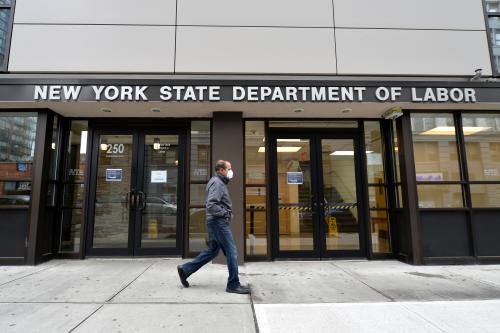The monthly jobs report—the unemployment rate from one survey and the change in employer payrolls from another survey—is one of the most closely watched economic indicators, particularly at a time of an economic crisis like today. Here’s a look at how these data are collected and how to interpret them during the COVID-19 pandemic.
What does the unemployment rate measure?
The headline unemployment rate measures the percentage of people over age 16 who aren’t working but are actively looking for work. The unemployment rate was hovering around a 50-year low before the pandemic, rose to 4.4% in March, and is certain to have been much higher in April. The Congressional Budget Office projects that the unemployment rate will rise to 16% this summer.
Where do the data on unemployment come from?
Data on unemployment are collected every month in the Current Population Survey (CPS), a survey of about 60,000 households, conducted by the Census and the Bureau of Labor Statistics every month, which includes roughly 105,000 people ages 16 and older. The questions about unemployment refer to what people were doing during the week that includes the 12th of the month, known as the “reference week”—so in the case of the survey to be released on Friday (May 8) the week of April 12. The CPS is also referred to as the household survey, to distinguish it from the establishment survey, which is the source for the official employment numbers released each month.
What questions are people asked to determine if they are marked “unemployed” in the monthly survey?
First, they are asked whether they worked during the week of April 12. People are counted as employed if they did any work at all as a paid employee, if they worked in their own business, or worked without pay for at least 15 hours in a family business. People are also counted as employed if they were temporarily absent from work as a result of sickness, bad weather, vacation, a strike, or personal reasons. Such workers are classified as employed but absent from work. People not counted as employed are then asked if they have both looked for work in the previous four weeks and are available to work. If so, they are counted as unemployed. In addition, people who did not work, but are on temporary layoff from a job with the expectation that they will be recalled—what many furloughed employees are experiencing today—are counted as unemployed whether they looked for a job or not.
What’s the difference between being unemployed and being out of the labor force?
People who are not working and who don’t meet the criteria to be counted as unemployed for the headline unemployment rate (known as U-3) are counted as being out of the labor force. This category includes students, retirees, and those who stay home to take care of family members. In addition, people who report wanting a job but have not looked for work in the most recent four weeks are considered out of the labor force, but they are not ignored in the official statistics. The Bureau of Labor Statistics (BLS) reports several measures of the labor market beyond the headline unemployment rate. The U-6, for instance, counts all those who are technically unemployed plus those are who are working part-time but would prefer full time work and those “marginally attached to the labor force,” that is, people who say they want either a full-time or part-time job, have not looked for work in the most recent four weeks, but have looked for a job sometime in the past 12 months. When adults classified as “marginally attached” report that they did not recently seek work because they do not believe jobs are available for them, they are classified as “discouraged workers.”
Why is it trickier to determine if people are unemployed in the COVID-19 pandemic?
While the survey will be the same as always, the nature of the COVID-19 economy means that people’s behavior, and hence the data, may not follow the same pattern that we usually see when the economy is turning down. Typically, people who lose jobs in recessions are more likely to transition into unemployment than to transition out of the labor force. However, with stay-at-home orders in place and nonessential businesses closed in many communities, people who leave employment now are much less likely to be seeking work than would typically be the case. In addition, schools are closed in many places, which means that many people who lost their jobs have child-care responsibilities that prevent them from seeking or accepting a new job. These dynamics mean that, relative to a typical downturn, we might expect the headline unemployment rate to rise less and the percent of those out of the labor force to raise more, especially the percent of those who say they want a job but aren’t looking. Indeed, we saw evidence of this in March, when, relative to the prior trend, an additional 1.2 million people moved from employment to out of the labor force, and the number of people categorized as out of the labor force but wanting a job rose by 500,000. The resulting increase in the labor force participation rate was much higher than would be expected given the rise in the unemployment rate.
What are “initial claims” for unemployment insurance?
When people first file for unemployment insurance (UI), they are counted as an “initial claim.” So when unemployment increases, initial claims tend to rise. Because initial claims are reported weekly, they are often used as an early indicator of the overall unemployment rate.
What is the relationship between initial claims and the unemployment rate — and why might it be different now?
The number of people receiving UI and the number counted as unemployed do tend to move in the same direction, but there is no formal link between the two indicators. The only criteria for being counted as unemployed (and hence included in the unemployment rate) are that you are without a job and that you have actively searched for work or are on temporary layoff. You need not be collecting unemployment insurance to be counted as unemployed. And some people are eligible to collect partial unemployment insurance benefits if they are working but have been assigned a schedule that is far below their usual weekly hours.
Many people who become unemployed do not apply for UI benefits, either because they are not eligible or because they choose not to apply. So initial claims typically understate the number of people becoming unemployed in a given week. That said, there are people who file an initial claim and are not counted as unemployed in the CPS. This could happen if a person doesn’t meet the CPS criteria for being unemployed, for instance if they file for UI because their work schedule was reduced, or if the person has a very short spell of unemployment which is not captured in the CPS (for example a person who becomes unemployed and finds a job in t between survey reference weeks).
Furthermore, many people who are unemployed and do file an initial claim do not end up receiving unemployment insurance benefits, either because they are not covered by the program, because they have not accumulated enough working hours to be eligible for benefits, or because they don’t satisfy the job search requirements. In February, before the pandemic, the number of people unemployed was about 5.8 million while the number of people receiving UI benefits averaged only about 1.7 million.
Will workers receiving special COVID-related UI benefits put in place by the CARES Act be counted as unemployed?
Not necessarily.
The recently enacted CARES Act increased the pool of people eligible for UI benefits and temporarily increased benefits by $600 a week. These changes will affect the usual relationship between the number of people receiving UI and the number of people counted as unemployed in the direction of increasing the share of the unemployed who receive benefits. Specifically, the CARES Act expanded UI eligibility to include the self-employed, contractors, and gig workers. Moreover, the CARES Act enables individuals to collect UI benefits for additional reasons. For instance, individuals may collect UI benefits if they are quarantined with the expectation of returning to work after the quarantine is over or if they leave employment due to a risk of exposure, due to infection, or to care for a family member (either because the family member is sick or because the typical care arrangement has been disrupted by the virus). Although many states appear to be interpreting these changes very narrowly, taken together they nonetheless imply that a greater share of the unemployed will receive UI benefits.
The CARES Act also allows states to waive the requirement that people must search for work to be eligible for benefits. As of early May, 40 states have waived the search requirements under certain circumstances. As a result, more UI beneficiaries than usual won’t be actively looking for work, which suggests that fewer UI recipients than usual will be categorized as being unemployed. However, whether they are counted as unemployed or not will depend on what they tell the government survey-taker about their expectation of being recalled. If they expect to be recalled, the CPS considers them on temporary layoff and counts them as unemployed; if they do not expect to be recalled they are counted as out of the labor force. Note that, while the CPS questions are designed to elicit consist responses across survey participants, identically situated individuals could be classified differently depending on how they view their likelihood of being recalled.
A final consideration: the CARES Act does not require a person impacted by COVID-19 to quit their jobs in order to receive benefits. The CPS counts people as employed if they have a job but are absent temporarily due to a variety of circumstances including illness and childcare problems. In March, the BLS instructed survey interviewers to classify employed persons absent from work due to corona virus-related business closures as unemployed or on temporary layoff. However, the BLS itself noted that there were still an unusually large number of individuals classified as employed and temporarily absent. This outcome suggests that the rule will likely reduce the share of people receiving UI benefits who are counted as unemployed.
The bottom line: The number of people receiving UI benefits during the COVID-19 crisis may rise more sharply than the number of people counted as unemployed.
What is the payroll survey? And why is it likely to be less useful than usual?
The payroll (or establishment) survey is a survey of 145,000 businesses—employing about one third of all workers on nonfarm payrolls—administered by the BLS. The payroll survey tends to have difficulty estimating employment growth when the economy is at a turning point, as is the case now. To create the sample to be surveyed, the BLS picks firms from the universe of firms that have unemployment insurance tax accounts. However, new firms do not enter the BLS sample universe right away, and the BLS can have difficulty distinguishing a nonresponse from a firm closure in real time. Since the net contribution of jobs created at new firms and jobs destroyed at closing firms is typically small, the BLS imputes the same trend change in employment as occurred at continuing firms to firms that close (or for those who do not respond). It then uses a model, called the net birth-death model, to forecast the residual between that imputation and the actual data. This model tends to overestimate employment growth when the economy is weakening and underestimate it when the economy is improving. And while the model error is typically small, it can, on occasion, be large.
The way that we know about these forecast errors is because in March of each year, the BLS revises the data based on more complete information. These revisions include benchmarking the level of payroll employment to population employment, primarily using the unemployment insurance tax records (published in the BLS’ Quarterly Census of Employment and Wages), which represent the near-universe of employment for the payroll survey data. Although there are a few factors that can cause the level of payroll employment to deviate from population employment, the failure to adequately account for net births and deaths is likely the most important. In most years the benchmark is small, with the level of employment revising up or down by less than 0.2 percentage points. However, strikingly, when the establishment survey data for March 2009—the depths of the Great Recession—were benchmarked, the level of payroll employment was revised down by over 900,000 jobs, or 0.7 percentage point, meaning that employers had shed an 75,000 more jobs each month between April 2008 and March 2009 than previously estimated.
If, as a result of the pandemic, an unusually large number of firms are closing and few are opening, it seems possible that the even the dramatic decline in employment that we are likely to see will underestimate the true extent of job loss.
Why might the historical link between unemployment and poverty be a misleading way to look at today’s numbers?
When people become unemployed, they lose an important (and sometimes their only) source of income and are at risk of falling into poverty. Of course, the more generous the unemployment insurance, the less likely it is for someone who loses a job to become poor. But unemployment insurance has typically replaced only about 40 percent of lost wages, on average over the past 20 years, with a lot of variation in generosity across the states.
The CARES Act changed that. It boosted the weekly unemployment insurance benefit by $600 through the end of July. This increase will more than double weekly UI benefits except in the case of laid-off workers who earn high wages. This UI benefit hike will go a long way toward preventing eligible families from falling into poverty.
In addition, the federal government is making direct payments of up to $1,200 per adult and $500 per dependent child under the age of 18, with the payments phasing out for those with higher levels of income. It also has encouraged states to request waivers that would allow them to increase SNAP (or food stamps) benefits and suspend time limits for able-bodied adults without children. That said, given the decline in economic activity, many households will still be facing very difficult economic conditions in coming months.







Commentary
Making sense of the monthly jobs report during the COVID-19 pandemic
May 5, 2020